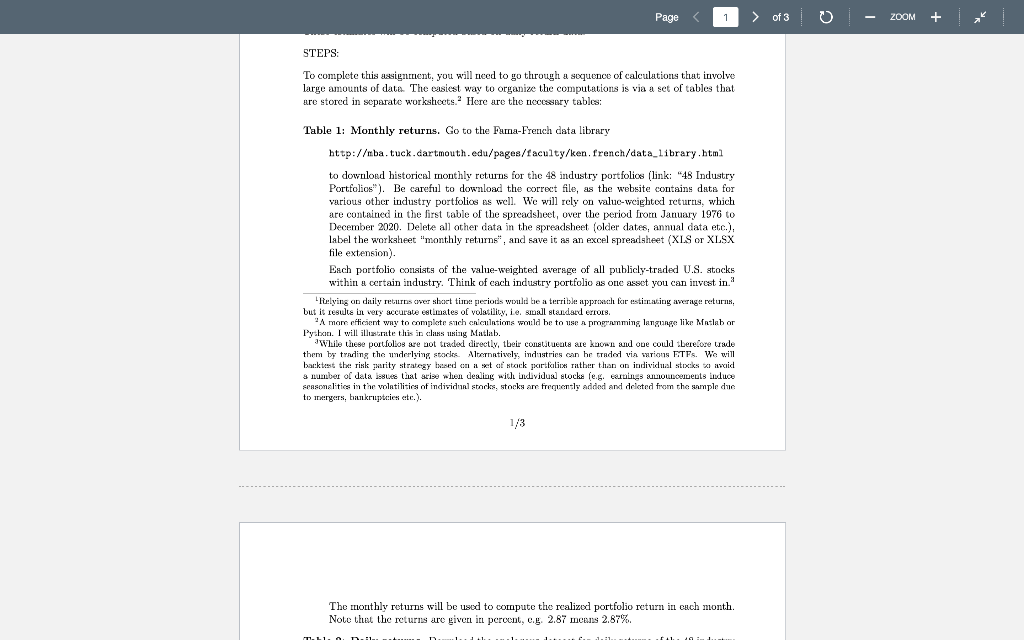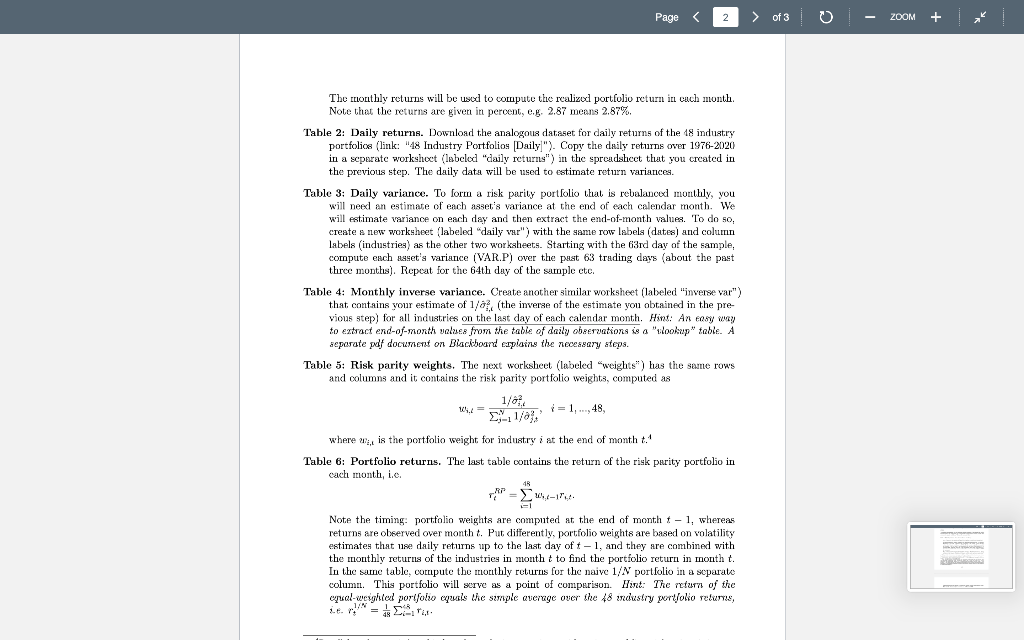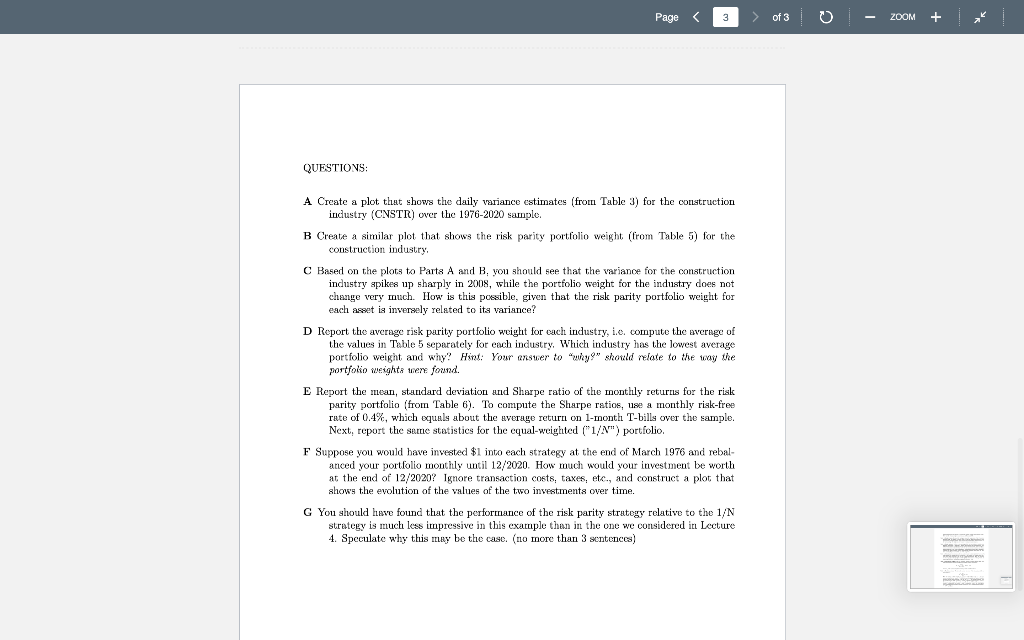


Page of 3 ZOOM STEPS To complete this assignment, you will need to go through a sequence of calculations that involve large amounts of data. The easiest way to organize the computations is via a set of tables that are stored in separate workstoets. Here are the necessary tables: Table 1: Monthly returns. Go to the Fama-French data library http://mba.tuck.dartmouth.edu/pages/faculty/ken.french/data_library.html to download historical monthly returns for the 48 industry portfolios (link: "48 Industry Portfolios"). Be careful to download the correct file, as the website contains data for various other industry portfolios as well. We will rely on value-weighted returns, which are contained in the first table of the spreadsheet, over the period from January 1976 to December 2020. Delete all other data in the spreadsheet folder dates, annual data etc.), label the worksheet "monthly returns, and save it as an excel spreadsheet (XLS OF XLSX file extension). Esch portfolio consists of the value-weighted average of all publicly-traded U.S. stocks within a certain industry. Think of each industry portfolio as one asset you can invest in Relying on daily returns cover short time periods would be a terrible approach for estimating average returns, but it results in very succurate estimates of volatility, i.e. small standard errors. A more efficient way to complete such criculations would be to use a pmguunming language like Matlab or yaban. I will illustrate this in class using Matlab. While these portfolios are not traded directly, their constituents are know and coe could berelore trade them by truling the underlying stocks. Alternatively, industries can he tradot via vious ETFs. We will backtest the risk qurity strategy tesed on a set of stock xirfalis rather than an individual stocks ta acid s number of data lesues that scise when dealing with individual stocke leg. emings umowcements induce seasonelitics in tae volatilitics of individual stacks, stocks are freciendly added and dricted from the sample due torrs, bunkrupties etc.). The monthly returns will be used to compute the realized portfolio return in cach month. Note that the returns are given in percent, c.g. 2.87 meus 2.87% Page > of 3 ZOOM The monthly returns will be used to compute the realized portfolio return in cuch month. Note that the returns are given in percent, c.g. 2.87 means 2.87% Table 2: Daily returns. Download the analogous dataset for daily returns of the 18 industry portfolice (link: "48 Industry Portfolios (Daily"). Copy the daily returns over 1976-2020 in a scperate worksheet (labeled "daily returns") in the sprcudstect that you created in the previous step. The daily data will be used to estimate return variances. Table 3: Daily variance. To form a risk parily portfolio that is rebalanced monthly, you will need an estimate of each asset's variance at the end of each calendar month. We will estimate variance on each day and then extract the end-of-month values. To do so, create a new worksheet (labeled daily var") with the same row labels (dates) and column labels (industries) as the other two worksheets. Starting with the 63rd day of the sample, compute ench Baset'a variance (VAR.P) over the past 63 trading days (about the past three months). Repeat for the 64th day of the sample etc. Table 4: Monthly inverse variance. Create another similar worksheet (labeled "inverse var") that contains your estimate of 1/6, (the inverse of the estimate you obtained in the pre- vious step) for all industries on the last day of each calendar month. Hint: An easy way to extract end-of-month values from the table of daily obeervations is a "vlookup table. A aeparate wf document on Blackboard esplains the necessary steps. Table 5: Risk parity weights. The next worksheet (labeled "weights") has the same rows and columns and it contains the risk parity portfolio weights, computed as 1/02 i = 1, ..., 48, where w, is the portfolio weight for industry i at the end of month 1." Table 6: Portfolio returns. The last table contains the return of the risk cach month, 1.o portfolio in Note the timing: portfolio weights are computed at the end of month 1 - 1, whereas returns are observed over month 1. Put differently, portfolio weights are based on volatility estimates use daily returns up to the last day of +-1, and they are combined with the monthly returns of the industries in month t to find the portfolio return in month t. In the same table, compute the monthly returns for the naive 1/N portfolio in a separato column. This portfolio will serve as a point of comparison. Hant: The return of the crual-weightel portfolio cyuks the smple average over the 48 meustry portfolio relurus, Page of 3 ZOOM QUESTIONS: A Create a plot that shows the daily variance estimates (from Table 3) for the construction industry (CNSTR) over the 1976-2020 sample. B Create a similar plot that shows the risk parity portfolio weight (from Table 5) for the construction industry, C Based on the plots to Parts A and B, you should see that the variance for the construction industry spikes up sharply in 2008, while the portfolio weight for the industry does not change very much. Ilow is this possible, given that the risk parity portfolio weight for each asset is inversely related to ita variance? D Report the average risk purity portfolio weight for each industry, i.e. compute the average of the values in Table 5 separately for each industry. Which inclustry has the lowest average portfolio weight and why? Hint: Your answer to you should relate to the way the portfolio weights were found. E Report the mean, standard deviation and Sharpe ratio of the monthly returns for the risk parity portfolio (from Table 6). To compute the Sharpe ratios, use a monthly risk-free rate of 0.4%, which equals about the average return on 1-month T-bills over the sample. Next, report the sette statistics for the cqual-weighted ("1/4") portfolio. F Suppose you would have invested $1 into each strategy at the end of March 1976 and rebal- anced your portfolio monthly until 12/2020. How much would your investment be worth at the end of 12/2020? Ignore transaction costs, taxes, etc., and construct a plot that shows the evolution of the values of the two investments over time. G You should have found that the performance of the risk parity strategy relative to the 1/N strategy is much less impressive in this example then in the one we considered in Lecture 4. Speculate why thuis may be the case. (no more than 3 sentences) Page of 3 ZOOM STEPS To complete this assignment, you will need to go through a sequence of calculations that involve large amounts of data. The easiest way to organize the computations is via a set of tables that are stored in separate workstoets. Here are the necessary tables: Table 1: Monthly returns. Go to the Fama-French data library http://mba.tuck.dartmouth.edu/pages/faculty/ken.french/data_library.html to download historical monthly returns for the 48 industry portfolios (link: "48 Industry Portfolios"). Be careful to download the correct file, as the website contains data for various other industry portfolios as well. We will rely on value-weighted returns, which are contained in the first table of the spreadsheet, over the period from January 1976 to December 2020. Delete all other data in the spreadsheet folder dates, annual data etc.), label the worksheet "monthly returns, and save it as an excel spreadsheet (XLS OF XLSX file extension). Esch portfolio consists of the value-weighted average of all publicly-traded U.S. stocks within a certain industry. Think of each industry portfolio as one asset you can invest in Relying on daily returns cover short time periods would be a terrible approach for estimating average returns, but it results in very succurate estimates of volatility, i.e. small standard errors. A more efficient way to complete such criculations would be to use a pmguunming language like Matlab or yaban. I will illustrate this in class using Matlab. While these portfolios are not traded directly, their constituents are know and coe could berelore trade them by truling the underlying stocks. Alternatively, industries can he tradot via vious ETFs. We will backtest the risk qurity strategy tesed on a set of stock xirfalis rather than an individual stocks ta acid s number of data lesues that scise when dealing with individual stocke leg. emings umowcements induce seasonelitics in tae volatilitics of individual stacks, stocks are freciendly added and dricted from the sample due torrs, bunkrupties etc.). The monthly returns will be used to compute the realized portfolio return in cach month. Note that the returns are given in percent, c.g. 2.87 meus 2.87% Page > of 3 ZOOM The monthly returns will be used to compute the realized portfolio return in cuch month. Note that the returns are given in percent, c.g. 2.87 means 2.87% Table 2: Daily returns. Download the analogous dataset for daily returns of the 18 industry portfolice (link: "48 Industry Portfolios (Daily"). Copy the daily returns over 1976-2020 in a scperate worksheet (labeled "daily returns") in the sprcudstect that you created in the previous step. The daily data will be used to estimate return variances. Table 3: Daily variance. To form a risk parily portfolio that is rebalanced monthly, you will need an estimate of each asset's variance at the end of each calendar month. We will estimate variance on each day and then extract the end-of-month values. To do so, create a new worksheet (labeled daily var") with the same row labels (dates) and column labels (industries) as the other two worksheets. Starting with the 63rd day of the sample, compute ench Baset'a variance (VAR.P) over the past 63 trading days (about the past three months). Repeat for the 64th day of the sample etc. Table 4: Monthly inverse variance. Create another similar worksheet (labeled "inverse var") that contains your estimate of 1/6, (the inverse of the estimate you obtained in the pre- vious step) for all industries on the last day of each calendar month. Hint: An easy way to extract end-of-month values from the table of daily obeervations is a "vlookup table. A aeparate wf document on Blackboard esplains the necessary steps. Table 5: Risk parity weights. The next worksheet (labeled "weights") has the same rows and columns and it contains the risk parity portfolio weights, computed as 1/02 i = 1, ..., 48, where w, is the portfolio weight for industry i at the end of month 1." Table 6: Portfolio returns. The last table contains the return of the risk cach month, 1.o portfolio in Note the timing: portfolio weights are computed at the end of month 1 - 1, whereas returns are observed over month 1. Put differently, portfolio weights are based on volatility estimates use daily returns up to the last day of +-1, and they are combined with the monthly returns of the industries in month t to find the portfolio return in month t. In the same table, compute the monthly returns for the naive 1/N portfolio in a separato column. This portfolio will serve as a point of comparison. Hant: The return of the crual-weightel portfolio cyuks the smple average over the 48 meustry portfolio relurus, Page of 3 ZOOM QUESTIONS: A Create a plot that shows the daily variance estimates (from Table 3) for the construction industry (CNSTR) over the 1976-2020 sample. B Create a similar plot that shows the risk parity portfolio weight (from Table 5) for the construction industry, C Based on the plots to Parts A and B, you should see that the variance for the construction industry spikes up sharply in 2008, while the portfolio weight for the industry does not change very much. Ilow is this possible, given that the risk parity portfolio weight for each asset is inversely related to ita variance? D Report the average risk purity portfolio weight for each industry, i.e. compute the average of the values in Table 5 separately for each industry. Which inclustry has the lowest average portfolio weight and why? Hint: Your answer to you should relate to the way the portfolio weights were found. E Report the mean, standard deviation and Sharpe ratio of the monthly returns for the risk parity portfolio (from Table 6). To compute the Sharpe ratios, use a monthly risk-free rate of 0.4%, which equals about the average return on 1-month T-bills over the sample. Next, report the sette statistics for the cqual-weighted ("1/4") portfolio. F Suppose you would have invested $1 into each strategy at the end of March 1976 and rebal- anced your portfolio monthly until 12/2020. How much would your investment be worth at the end of 12/2020? Ignore transaction costs, taxes, etc., and construct a plot that shows the evolution of the values of the two investments over time. G You should have found that the performance of the risk parity strategy relative to the 1/N strategy is much less impressive in this example then in the one we considered in Lecture 4. Speculate why thuis may be the case. (no more than 3 sentences)









